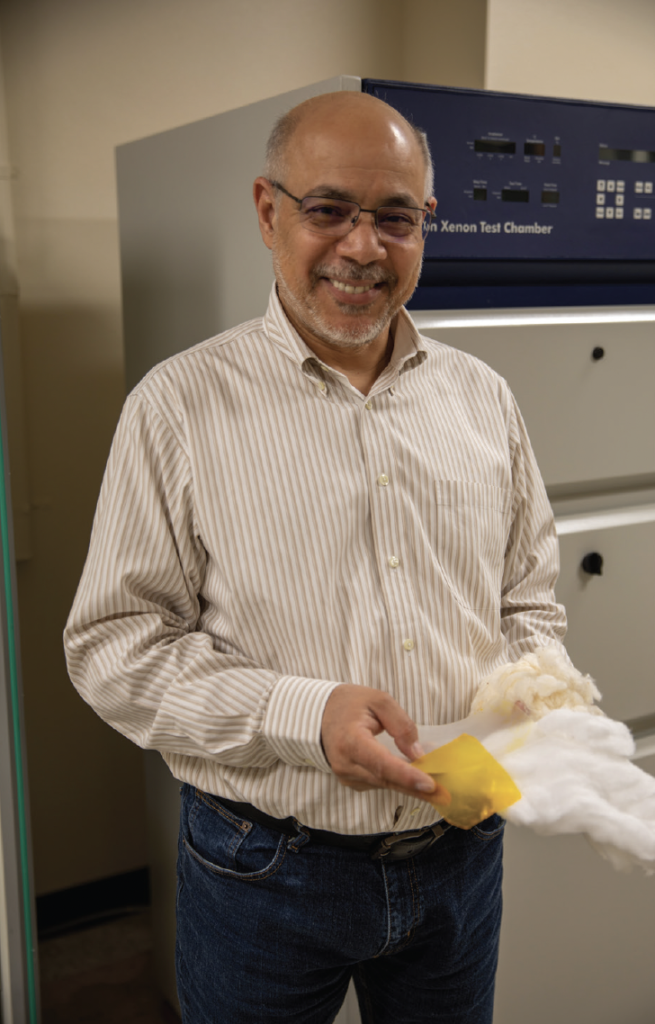
Dr. Noureddine Abidi, Texas Tech Professor and Director of FBRI
by Blair White
Hearing the words cotton and plastic in the same sentence, the first thought that might come to mind is contamination, followed by exasperated mutterings of “not again…” Don’t worry, that’s not what we’re talking about here. Instead, Dr. Noureddine Abidi, Texas Tech Professor and Director of the Fiber and Biopolymer Research Institute, is changing the game regarding cotton and plastic through his recent groundbreaking research.
Last October, Dr. Abidi received the 2020 Discover National Fibers Initiative Innovation Award for his work in helping make cotton and its byproducts more sustainable for the environment. Cotton is 99% cellulose, making it perfect for transforming into a wide range of products traditionally made from petroleum-based plastics. Dr. Abidi’s research led him to develop a process “to produce a plastic substitute from cotton by dissolving the fibers to form a gel, which can be transformed into bioproducts, including plastic films,” according to DNFI.
Abidi’s idea was born from an unlikely source – low micronaire (low mic) cotton sometimes produced by seasonal weather conditions. Low mic cotton features “fine or immature fibers that are easily compressed and have a lower air permeability,” according to the CottonWorksTM website.
“Because cotton growth is impacted by environmental conditions, every year some of our cotton production is classed as having low micronaire values,” he explained. “This cotton is heavily discounted because the global textile mills are interested in sourcing cotton with fiber profiles adapted to high-quality textile products. This means that cotton fibers should be long, uniform, mature, fine, and strong. It is important to find alternative uses of low micronaire cotton to help keep cotton prices high.”
DNFI reports that when cellulose-based plastics are buried in the soil, they decompose in roughly three weeks. However, when kept in average household conditions, they remain stable. This trailblazing discovery could revolutionize a range of commercial, agricultural, and household uses by providing environmentally friendly and genuinely bio-degradable plastics.
“Plastics have been part of our lives; however, the issue of non-degradability has created a major challenge,” Abidi said. “The major obstacle in converting cellulose to other materials (besides textiles) is its insolubility. We are now able to dissolve cellulose, form a gel, and convert the gel to various forms, including plastic-looking materials. We have been doing experiments to test the biodegradability in the soil. When cotton cellulose films are placed in the soil (moisture was maintained at 12 percent), biodegradation starts to occur around 23 days. Complete degradation occurs around 100 days. Microscopic observation showed the growth of microorganisms on the surface of the film, which initiated biodegradation. This research is still ongoing, but preliminary results illustrate the biodegradability of cotton cellulose films.”
This research points to many environmental benefits and the push for high-quality, sustainable cotton could not have come at a better time. Abidi said positioning the lower quality types of cotton as high-value-added materials can even help increase market share for growers.

Cotton industry and academic professionals gathered to present Dr. Abidi with his award in October 2020.
“If we can create a niche market for the low micronaire cotton, that will be of great benefit to the cotton industry,” Abidi said. “All cotton produced will have a market: high-quality cotton will have traditional textile applications, while low micronaire cotton will have niche applications such as bioplastics. Furthermore, there are growing environmental concerns regarding the accumulation of microplastics from synthetic fibers and materials, and the urgent need is to find alternatives to petroleum-based products. It is important to stress that this process is not targeting good quality cotton, which has its traditional textile market. This process focuses on low micronaire cotton, short fibers, linters, or cotton waste either at the gin or at the textile mills.”
From sustainability to profitability, the entire cotton industry will benefit from this discovery. When a grower has a tough year with lower quality fibers, that cotton will no longer go to waste. Low mic cotton now has a home and a purpose for making the world a more sustainable place – a mic drop for the industry.
Abidi already holds one patent for his innovation (US 10,311,993 B2). The patent focuses on the use of 3D printing with cellulose gel derived from cotton fibers. Two provisional patents are currently pending.


